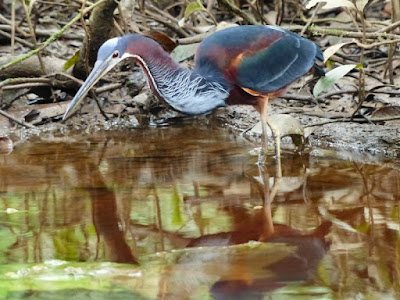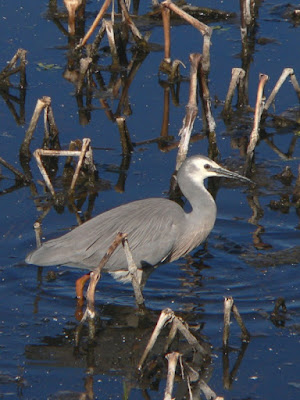Here I am again to complete last week's post on herons, a significant component of wetlands and waterways throughout most of the world. Having offered an overview last time, I want to introduce the groups and some representative species. I confess to feeling quite under the weather at present (no, not self-inflicted!), so this might turn out a little sketchier than intended - though concentrating on something as pleasurable as this topic could also take my mind off minor life-annoyances.
The taxonomy of herons is a very fluid situation, with changing understandings - and of course disagreements, that being the proper nature of science - at all levels, from delimitation of some species, to which species belong in which genera, to the basic breakdown of the family into subfamilies. As ever, I rely for taxonomy on the International Ornithological Congress (IOC) list - not because I think it's automatically the 'best' (inter alia I have no qualifications to judge it by) but because we all have to settle on one taxonomy and stick to it, and because they are excellent at keeping their lists updated, with reasons and references. (The IOC list doesn't concern itself with subfamilies, though the order of species they use can help us to deduce relationships to a large extent.) For most of us of course it doesn't really matter, though I find relationships interesting, and for a large family like this one it can help to subdivide.
Having said that, three of the subfamilies are relatively small, so subdivision per se isn't so useful here for breaking a large whole into more manageable chunks.
Tiger Herons and Boat-billed Heron; subfamily Tigriornithinae
This is an interesting and attractive small grouping comprising three species of South American tiger-herons, plus three somewhat enigmatic and far-flung single-species genera (the Boat-billed Heron from South America, the Forest Bittern (yes, I know it's confusing!) of New Guinea and the White-crested Tiger Heron of central and west Africa).
 |
| Fasciated Tiger-Heron Tigrisoma fasciatum Peruvian Amazonia; this species is more typical of forested streamsides higher in the Andes. |
 |
| Rufescent Tiger-Heron T. lineatum, Yasuní NP, Ecuadorian Amazonia. |
Bitterns: subfamily Botaurinae
The bitterns are secretive stocky herons of the reedbeds, 10 small species and four large ones (comprising two separate genera), plus the unusual rainforest Zigzag Heron of the Amazon basin. The large bitterns especially, which between them are found on all continents, emit dramatic booming calls during mating season, which can echo for kilometres. The name derives originally from a Latin term incorporating taurus, a bull.
Night Herons: family Nycticoracinae
This is the only contentious subfamily - there is some evidence that it should be subsumed into the day herons (below) but it is far from conclusive.
As you'd expect the birds are mostly nocturnal, roosting by day in trees near water. They are voracious predators - aviary birds are very scared when they're around.
 |
| Yellow-crowned Night Heron Nyctanassa violacea, Guayaquil, Ecuador. This species is found in the Americas, including the Galápagos, mostly in near-coastal tropics and subtropics. |
 |
| Black-crowned Night Heron Nycticorax nycticorax, Isla de Chiloé, Chile. This is a bird with a huge distribution, found in every continent except Australia. |
This is by far the largest heron subfamily, comprising some two thirds of all species. It is dominated by two largish genera, each with around 12 species, though there is still dissent as to which species belongs where. Let's just go through some of them.
Genus Ardea
 |
| The Great Blue Heron A. herodias (here on Santa Cruz, Galápagos) is found throughout North and Central America. It is one of the biggest herons in the world. |
 |
| Cocoi Heron A. cocoi, Manu River, Peruvian Amazonia. Cocois can be found on almost any non-montane waterway in South America; the name is from an indigenous name for it from the Caribbean area. |
 |
| Purple Heron A. purpurea, Limbe Botanic Gardens, Cameroon. This one has a very wide range across Africa, Europe and southern Asia. |
The other large genus in this subfamily, on average comprising smaller species.
 |
| Pacific Reef Heron E. sacra, Fraser Island, Queensland. Here both colour morphs occur together; to the north most birds are white. with dark ones to the south. |
 |
| Little Blue Heron E. caerulea, Arica, northern Chile. An elegant little heron found from the southern United States to the warmer coasts of South America. |
 |
| Snowy Egret E. thula, also at Arica. A very wide American range, covering the southern half of North America and most of South America except for the Andes. I love the yellow feet! |
Smaller genera of day herons
Finally there are a number (around six) of day heron genera with between one and six species. The largest of these comprises the pond herons, six species of mostly Asian or African small solid herons.  |
| Eastern Cattle Egrets B. coromandus with Water Buffaloes, Sabah (above) and with domestic cattle, Nowra, New South Wales (below). These birds are in their lovely breeding plumage. |
 |
| Striated Heron Butorides striatus Galápagos, adult above, juvenile below. This species also has a huge distribution, across South America, Europe, Africa and Australia. (See here for a photo of the Australian subspecies, from last week's posting.) However until recently this distribution was even greater, with North and Central American birds also included (they are now known as Green Herons B. virescens). |
 |
| Lava Heron B. sundevalli, Santa Cruz, Galápagos. This bird too was until recently included in the same world-wide species but is now seen as a Galápagos endemic. |
 |
| Capped Heron Pilherodius pileatus, Yasuní NP, Ecuador. A little-known and scarce heron, with a wide tropical distribution east of the Andes; the only one of its genus. |
Finally (!), another very lovely single-species genus from the Amazon basin
rainforests. The Agami Heron has been placed at times with the Tiger
Herons, or even cast from the entire heron family! That is not generally
accepted now though.
 |
| Agami Heron Agamia agami, Yasuní NP, Ecuador. This is a bird of which we know sadly little - I feel privileged to have even seen one. |
BACK ON THURSDAY
(And remember that you can get a reminder when the next post appears by putting your email address in the Follow by Email box in the top right of this screen.)
(And remember that you can get a reminder when the next post appears by putting your email address in the Follow by Email box in the top right of this screen.)


















3 comments:
Sorry to hear you are unwell Ian, I hope you have a speedy recovery.
Thanks for your kind thoughts Roman, I appreciate that. I'll get there!
We get 4 of the above species here in central France -- black-crowned night heron, purple heron, great and little egrets. Hope you feel better soon.
Post a Comment